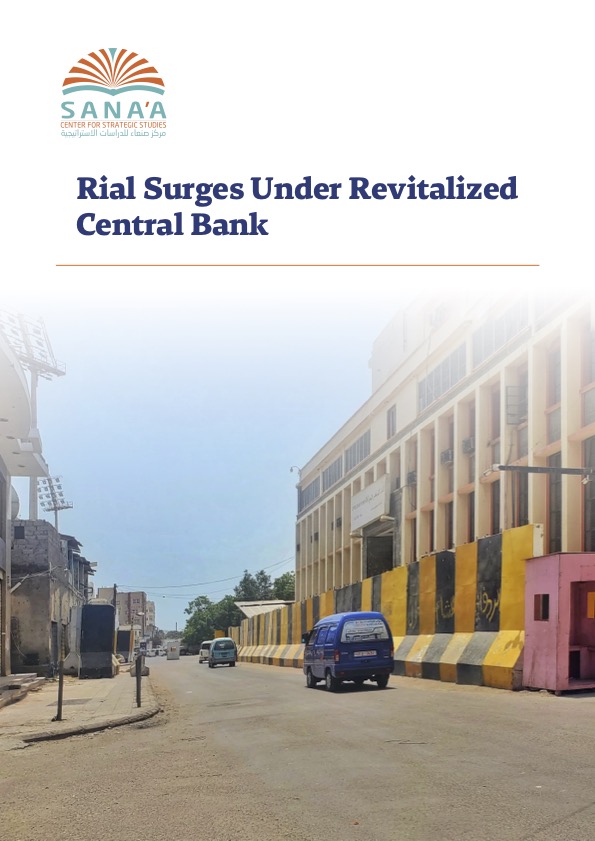The Yemeni rial has seen a dramatic recovery since late July, appreciating by over 44 percent after months of hemorrhaging value. Its sudden rise is the result of a multi-pronged approach led by the government-run Central Bank of Yemen in Aden (CBY-Aden). Key measures have included curbing speculation and currency manipulation, institutionalizing import financing, and mandating the exclusive use of the rial in domestic transactions. These reforms received unprecedented political backing from the Presidential Leadership Council (PLC), the government, and local authorities, a pivotal shift in combating the systemic weaknesses that have long undermined the stability of the currency.
By mid-July, the new Yemeni rial,[1] which circulates in government-controlled areas, had tumbled to YR2,900 per US$1, its worst collapse since the central bank split in 2016. Yemen is highly reliant on imports, and rapid inflation curbed purchasing power, deepening food insecurity and sparking widespread protests. But the rial’s decline was not just due to market forces, rather, it was the result of systematic efforts by money exchangers seeking to profit from arbitrage. Money exchange shops have proliferated as traditional banks struggle to navigate the conflict. Many have escaped regulation and have exploited the lack of oversight to engage in illegal speculation. Influential political, military, and security actors have been implicated in such schemes, as have major commercial entities. CBY-Aden Governor Ahmed Ghaleb al-Maabqi openly accused the Houthis of engaging in currency speculation in Aden in an attempt to sabotage the market.
On July 24, the CBY-Aden moved to shut down such operations, launching an on-site inspection campaign to curb currency speculation and manipulation, and suspending or revoking the licenses of over 50 money exchange outlets. With the support of the government and local authorities, this long-overdue enforcement of financial regulations appears to have been vital in halting the rial’s depreciation.
Past efforts to reverse the rial’s decline saw limited support from politicians – and not just those implicated in domestic profiteering. Foreign interference has repeatedly undermined the CBY-Aden’s efforts to assert its authority and support the currency. To preserve its “roadmap” to peace, Saudi Arabia pressured the government to reverse efforts to regulate the financial sector and isolate the Houthis financially. The abandonment of the Unified Money Transfer Network and other measures weakened the central bank’s capacity to combat destabilizing financial activities, putting downward pressure on the rial. And despite public pledges to replenish the CBY-Aden’s foreign currency reserves, Saudi financial assistance has been slow and unpredictable. The central bank is estimated to hold a meager US$225 million, and the scarcity of its reserves has driven speculation in the parallel exchange market.
Unable to assert its authority over the national financial system and undermined by wavering support from Riyadh, the central bank was thrown an unexpected lifeline from the US. The Treasury Department’s redesignation of the Houthis as a Foreign Terrorist Organization (FTO) in January is dangerous for Yemen – its broad scope threatens further economic isolation and the reliable import and delivery of food and aid. But it has served to force Yemeni financial institutions under Aden’s authority. The threat of sanctions has led banks in Houthi-controlled Sana’a to relocate their main operations to government-controlled areas, bolstering the CBY-Aden’s capacity to monitor operations and remittance flows—a critical step for supporting the rial.
The government has also gotten its act together. After months of competing and uncoordinated initiatives, its divided factions agreed on a unified approach to address the currency crisis. One result is the establishment of a National Committee for Regulating and Financing Imports and a new mechanism for trade. Requests to import any of 25 essential commodities—including food, medicine, and petroleum derivatives—must now be submitted through Yemeni banks and exchange companies for the committee’s review. Unapproved shipments will be denied entry through customs, a powerful deterrent against unregulated financing.
This is a long-overdue reform. Ever since the central bank was divided, the government-affiliated Aden branch has been unable to establish an effective import financing mechanism. The Houthis established their own payments committee for this purpose in late 2017, but the CBY-Aden instead sought to support the new rial by auctioning foreign currency for import financing. The auctions, launched in late 2021, were largely unsuccessful – subscription rates fell below 50 percent due to a Houthi ban on participation and limited interest from commercial banks. The long delay in establishing an import finance committee suggests that the government failed to grasp the importance of import regulation in controlling demand for hard currency.
Still, challenges to the rial’s rehabilitation persist. The financial infrastructure for controlling foreign currency flows remains weak, and transparency remains a concern. The complex web of shared ownership and interests between government authorities, commercial houses, banks, and exchange outlets can blur the line between legitimate trade and speculation and profiteering. Many large commercial traders have their own banks and exchange companies, and have leveraged these channels to finance imports or profit from speculation. Institutional and regulatory fragmentation has shifted parts of the monetary cycle to exchanges operating outside the central bank’s oversight. The central bank has struggled to remove excess liquidity through foreign currency auctions or debt instruments.
In response, the government has moved to bolster the rial against other circulating currencies. In early August, the Cabinet restricted the use of foreign currencies for commercial transactions and financial contracts. Various private and public entities—including Yemenia Airlines and the Public Telecommunications Corporation— had collected payments and fees in foreign currencies, placing downward pressure on the rial. However, the new resolution’s impact will be limited, as it fails to restrict payments made outside the public budget. This violates existing fiscal law, which mandates use of the rial as the primary unit of exchange for all government expenditures. Thousands of high-ranking officials, including members of the PLC, cabinet, and members of various military forces, receive their salaries or bonuses in US dollars or Saudi riyals, outside the official budget. Many spend little time in Yemen. This perpetuates a dual-currency system that not only deprives the government of foreign exchange for its reserves and stabilization efforts, but threatens the monetary sovereignty of the central bank.
The recent rise in the rial’s value could mark a shift toward a more cohesive macroeconomic strategy by the government. However, the recovery will be temporary absent broader economic reforms. Long-term stability demands a two-pronged approach: transforming recent interventions into sustainable policies and implementing deeper structural changes. The CBY-Aden is only as strong as the support it receives. Reform will require political will and enforcement from every level and faction of the government, along with respect for the monetary independence of the central bank.
It also requires a reliable source of revenue for the government. The Houthi blockade of oil exports has made it dangerously dependent on irregular Saudi support. While Riyadh and Abu Dhabi are quick to pay wages to the armed groups it supports, the government desperately requires a sustainable source of hard currency to finance trade and provide basic services. Still, there are numerous opportunities to address deficiencies in the fiscal system to mobilize revenues and rationalize expenditures. The government should combat corruption within sovereign institutions, such as the Customs and Tax Authority, and liberalize the customs dollar exchange rate, which currently favors importers. Implementing a tiered electricity tariff system could reduce the financial deficit and help keep the lights on.
The government’s disparate members must undertake such efforts in concert to be successful. Further, they must be proactive in pursuing financial reform and not wait for widespread civil unrest or imminent economic collapse to act. It is dangerous to walk so close to the cliff.
This analysis is part of a series of publications produced by the Sana’a Center and funded by the government of the Kingdom of the Netherlands. The series explores issues within economic, political, and environmental themes, aiming to inform discussion and policymaking related to Yemen that foster sustainable peace. Any views expressed within should not be construed as representing the Sana’a Center or the Dutch government.
- ”Old” rials are banknotes issued prior to 2017, while “new” rials are those issued subsequently by the CBY-Aden. In January 2020, Houthi authorities banned new rials from circulating in areas under the group’s control. This has spurred divergent exchange rates between the old and new banknotes, with the former circulating predominantly in Houthi-controlled areas and the latter in government-controlled areas.

 اقرأ المحتوى باللغة العربية
اقرأ المحتوى باللغة العربية
